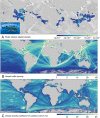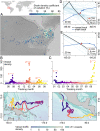Global collision-risk hotspots of marine traffic and the world's largest fish, the whale shark
- PMID: 35533277
- PMCID: PMC9171791
- DOI: 10.1073/pnas.2117440119
Global collision-risk hotspots of marine traffic and the world's largest fish, the whale shark
Abstract
Marine traffic is increasing globally yet collisions with endangered megafauna such as whales, sea turtles, and planktivorous sharks go largely undetected or unreported. Collisions leading to mortality can have population-level consequences for endangered species. Hence, identifying simultaneous space use of megafauna and shipping throughout ranges may reveal as-yet-unknown spatial targets requiring conservation. However, global studies tracking megafauna and shipping occurrences are lacking. Here we combine satellite-tracked movements of the whale shark, Rhincodon typus, and vessel activity to show that 92% of sharks’ horizontal space use and nearly 50% of vertical space use overlap with persistent large vessel (>300 gross tons) traffic. Collision-risk estimates correlated with reported whale shark mortality from ship strikes, indicating higher mortality in areas with greatest overlap. Hotspots of potential collision risk were evident in all major oceans, predominantly from overlap with cargo and tanker vessels, and were concentrated in gulf regions, where dense traffic co-occurred with seasonal shark movements. Nearly a third of whale shark hotspots overlapped with the highest collision-risk areas, with the last known locations of tracked sharks coinciding with busier shipping routes more often than expected. Depth-recording tags provided evidence for sinking, likely dead, whale sharks, suggesting substantial “cryptic” lethal ship strikes are possible, which could explain why whale shark population declines continue despite international protection and low fishing-induced mortality. Mitigation measures to reduce ship-strike risk should be considered to conserve this species and other ocean giants that are likely experiencing similar impacts from growing global vessel traffic.
Keywords: conservation; human impact; marine megafauna; movement ecology; ship strike.
Conflict of interest statement
The authors declare no competing interest.
Figures





References
-
- United Nations Conference on Trade and Development (UNCTAD), Review of maritime transport 2020 (2020). https://unctad.org/system/files/official-document/rmt2020_en.pdf. Accessed 25 January 2022.
-
- United Nations Conference on Trade and Development (UNCTAD), Review of maritime transport 1995 (1995). https://unctad.org/system/files/official-document/rmt1995_en.pdf. Accessed 25 January 2022.
-
- Sequeira A. M. M., et al. , Overhauling ocean spatial planning to improve marine megafauna conservation. Front. Mar. Sci. 6, 639 (2019).
-
- Schoeman R. P., Patterson-Abrolat C., Plön S., A global review of vessel collisions with marine animals. Front. Mar. Sci. 7, 292 (2020).
-
- Queiroz N., et al. , Global spatial risk assessment of sharks under the footprint of fisheries. Nature 572, 461–466 (2019). - PubMed
Publication types
MeSH terms
LinkOut - more resources
Full Text Sources

